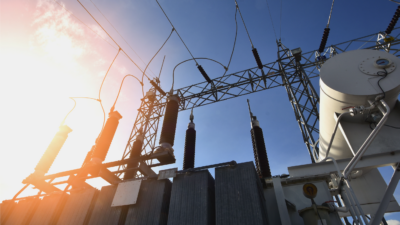Also called variable capacitors, adjustable capacitors and tuning capacitors, here’s how they work and when to use them.
This article is part of The engineer’s complete guide to capacitors. If you’re unsure of what type of capacitor is best for your circuit, read How to choose the right capacitor for any application.
What is an air variable capacitor?
Air variable capacitors are also called variable capacitors, adjustable capacitors and tuning capacitors. The plates form half circles with one set of stationary plates and another set that rotates on an attached shaft. Maximum capacitance is achieved when the plates are fully meshed.

How does an air variable capacitor work?
Capacitors store electrical energy. The energy (W) in joules is determined by the capacitance (C) and the voltage across the capacitor (V). Specially, for all capacitors W = ½ CV2. The relative permittivity (dielectric constant) value of a material is a measure of the amount of energy stored in a material for a given voltage. The relative permittivity (εr), the plate area (A), and the distance between the plates (d) determine the capacitance value according to C = εr A/d. The relative permittivity of air is nearly that of vacuum, which has the lowest possible dielectric value of εo = 1. This means that a capacitor must be physically large to possess a large value of capacitance.
Another important factor is the voltage rating of a capacitor. The dielectric strength limits the maximum voltage that can be applied to a material before it breaks down. When a material (for example, an insulator or dielectric) experiences voltage breakdown, it loses its insulator and dielectric properties and starts acting like a conductor. In the case of the air variable capacitor, the maximum voltage rating is determined by the distance between the plates. Since the capacitance is inversely proportional to the distance between the plates, a compromise is required to achieve the desired capacitance and the required voltage rating. These considerations also determine the physical size of the capacitor.
Applications of air variable capacitors
Air variable capacitors are used to tune L-C resonant circuits found in radio frequency power amplifiers. They are also found in antenna impedance matching networks. Their simple design offers high voltage ratings, low leakage and a high quality factor (Q). Air variable capacitors are non-polarized. The capacitance can be as small as 10 pF or as large as 1000 pF. The maximum operating voltage depends on the capacitor’s physical size.
Several different physical configurations of air variable capacitors are available. The minimum and maximum capacitance values, and the maximum RMS voltage and current ratings, determine the physical characteristics.
Alternatives to air variable capacitors
Other variable capacitor types exist, such as variable glass capacitors for high-temperature applications with a high Q; trimmer capacitors with plastic dielectrics with much lower RMS voltage, current ratings and Q values; adjustable mica capacitors, though these have small capacitance values with a limited adjustment range; and voltage variable capacitors or varactor diodes that provide the advantage of no moving parts at the expense of much lower voltage, current and Q values.



